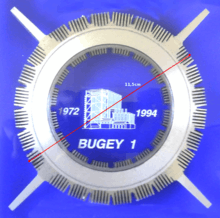UNGG reactor
.jpg)

The UNGG (Uranium Naturel Graphite Gaz) is an obsolete nuclear power reactor design developed by France. It was graphite moderated, cooled by carbon dioxide, and fueled with natural uranium metal. The first generation of French nuclear power stations were UNGGs, as was Vandellos unit 1 in Spain. Of ten units built, all were shut down by end 1994, most for economic reasons due to staffing costs.
The UNGG and the Magnox are the two main types of gas cooled reactor (GCR). A UNGG reactor is often referred to simply as a GCR in English documents, or sometimes loosely as a Magnox. It was developed independently of and in parallel to the British Magnox design, and to meet similar requirements. The first UNGG reactors at Marcoule used horizontal fuel channels and a concrete containment structure. Chinon A1 used vertical fuel channels, as did the British Magnox reactors, and a steel pressure-vessel.[1]
The fuel cladding material was magnesium-zirconium alloy in the UNGG, as opposed to magnesium-aluminium in Magnox. As both claddings react with water, they can be stored in a spent fuel pool for short times only, making short-term reprocessing of the fuel essential, and requiring heavily shielded facilities for this.
The programme was a succession of units, with changes to the design increasing power output. In the experimental phase they were built by the Commissariat à l'Énergie Atomique (CEA), and later by Électricité de France (EDF).[1] The largest UNGG reactor build was Bugey 1 with a net electrical output of 540 MW.
Units
- G1, G2 and G3 at Marcoule. G1 was the first UNGG to go critical, in 1956.
- Chinon Nuclear Power Plant A1, A2, and A3 in Indre-et-Loire.
- Saint-Laurent Nuclear Power Plant A1 and A2 in Loir-et-Cher, operated from 1969 and 1971 to April 1990 and June 1992.
- Reactor 1 at Bugey Nuclear Power Plant in Ain, the last UNGG built in France, first criticality 1972, closed May 1994.
- Vandellòs Nuclear Power Plant Unit 1 in Spain, the only UNGG built outside France, closed July 1990.
The earlier units, at Chinon and Marcoule, had heat exchangers outside the main pressure vessel; Later units (Saint-Laurent, Bugey and Vandellos) moved these heat exchangers to inside the pressure vessel.
See also
References
- 1 2 Ten Years of Nuclear Power (PDF) (Report). UKAEA. 1966. Retrieved 15 January 2015.
Sources and external links
- French activities on gas cooled reactors, D Bastien, IAEA-TECDOC—899, pp:51-53, 30 Oct - 2 Nov 1995
- Twenty-nine years of French experience in operating gas-cooled reactors, D Bastien, IWGGCR—19, pp:113-119 21-23 Sep 1988